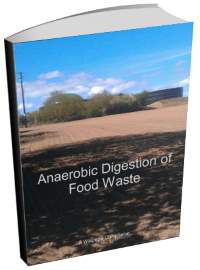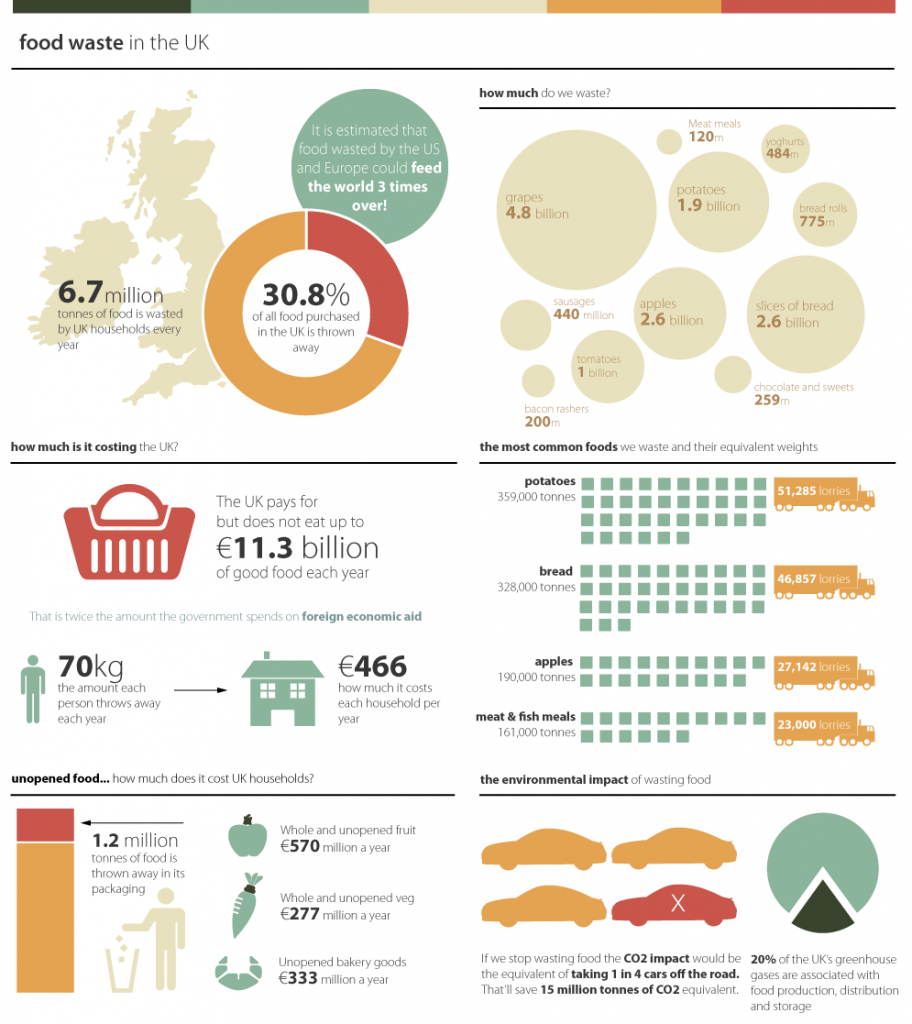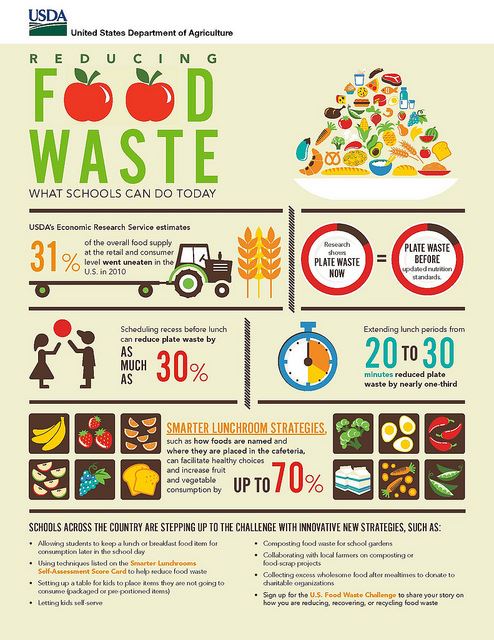The anaerobic digestion of food waste is an important application for AD technology. It is the number one preferred method for treating and disposing of food waste according to the Waste Hierarchy, above composting, and certainly a long way better than sending it to landfills.
Many EU nations are placing legal requirements on local authorities to make them collect source-separated food in caddies, and dispose of it via biogas plants to create energy and renewable fertilisers.
Indeed, in some countries, (for example, Wales) waste collection authorities are already required to do this. In the US it is being introduced, and in England, separate food waste collection will be required from households throughout all areas by 2026.
Why Minimising, Re-Using and Recycling Food Waste is So Important
Food waste disposal and treatment have become a big issue in most industrialised countries. Producing food is a huge burden on the planet. To waste about 1/3rd of it, as most developed nations do at present, adds a huge additional burden on the environment for no benefit at all.
According to statistics shared in a recent WRAP campaign about the impact food waste has on our planet, 6.6 million tonnes of household food waste is thrown away in the UK each year.
This food waste accounts for nearly 25 million tonnes of CO2 emissions, or 5.4% of the UK's total emissions. The vast majority, 4.5 million tonnes, is food that could have been consumed and is worth approximately £14 billion (£60 per month for an average UK family). via Biotech4.co.uk
Relative to other food waste recycling methods the use of the AD process, for this purpose is relatively new, but anaerobic digestion is the UK Government's preferred disposal option. Many communities are now sending their food waste to anaerobic digestion.
Next! Watch our video on the benefits of anaerobic digestion of food waste below. It's all about the benefits of food waste collection and recycling through anaerobic digestion:
<< A new video is coming soon >>
Why the Costs of the Anaerobic Digestion of UK Food Waste are Falling
The anaerobic digestion of food waste was once expensive, with one UK local authority stating that their (2013/14) cost per tonne for their collected domestic food waste was a massive £267/tonne (including all collection and transport costs to the AD plant).
However, starting in 2017, the gate fee for accepting local authority source-segregated food waste has dropped.
Initially, this was due to competition for the available waste, and many new Food Waste AD Plants were commissioned in the UK in the period up to 2017. This resulted in the development of a competitive market among the anaerobic digestion plants offering the recycling of food waste.
Nowadays (as of 2022), the choice of whether or not to collect food waste and treat it in AD plants is much easier, as higher energy prices combined with the decarbonization targets of many large companies have raised the value of biogas, especially when upgraded to biomethane.
Prices paid for curbside-collected municipal food waste vary enormously across the UK. But, there may be savings to be achieved for local authorities, and businesses by opting for food waste anaerobic digestion.
In most areas, where a food waste biogas plant is available, the cost of disposal is now below the cost of landfilling, which of course, includes the cost of the Landfill Tax.
The benefits of food waste composting don't stop there. Far from it. We think that there are at least 10 benefits from the anaerobic digestion of food waste, and we have made our own video about it, which we provide below. Please watch our video, and then scroll down for more food waste recycling, and anaerobic digestion of food waste facts.
As the other “easier to achieve” waste reductions have been gradually picked-off, more and more attention is having to be paid to the anaerobic digestion of these household food waste streams. This is to comply with European Regulations on waste diversion from landfill and increasingly more onerous recycling targets.
Recent UK Research Shows Unexpected Cost Savings from Source Separated Household Food Waste Collection
Recent UK research has shown that source-separated food waste collections, when soon introduced throughout England, when combined with the anaerobic digestion of food waste may actually save ratepayers money!
The following are the reasons given for this:
- The government continues to escalate the landfill tax for disposal of all MSW (including food waste) to landfills and the charge is well above £100/tonne.
- The public in England is reacting well to new source-separated kitchen waste (caddy) collections and the diversion rate is close to the target rates on average for the new collections as long as the council supplies caddy liners free of charge.
- At the level of diversion being achieved the reduced tonnage of waste sent to landfill provides a cost saving.
- Above and beyond that, in all areas, the total waste tonnage collected has reduced, only slightly but by a measurable amount. It is thought that the fact that while using their caddies to recycle their food waste people are thinking more about their overall wastefulness.
- Acceptance of food waste at biogas facilities was until 2022 subject to a gate fee charged to local authorities. However, this has reversed due to massive rises in energy costs during 2021/22. The resulting high demand for biomethane produced by food waste AD plants means that many biogas plant operators are willing to pay local authorities for source-separated food waste. Source: LetsRecycle
- For the first time in August 2022, the LetsRecycle pricing for “anaerobic digestion of food waste” is shown in the range of £25/tonne to £0.00/tonne paid for incoming food waste (i.e. for the first time LAs can deliver their source-separated food waste without paying gate fees and many will be paid for each delivery).
The quantity of food waste is large! The image below explains that point very effectively:
© Copyright GDS Infographics licensed for reuse under CC BY 2.0 https://www.flickr.com/photos/gdsdigital/4138675384/
But to look at it from the point of view of a biogas plant operator, food waste is an excellent feedstock for the new generation of anaerobic digestors. Food waste is readily digested within them. Anaerobic Digestion technology-based Waste Treatment Plants which accept a high proportion of food waste will also be, in principle, more economic to run than the equivalent non-food waste-fed plants such as biomass, food crop, and manure-fed plants. This is due to the high methane gas-producing potential and thus the revenue potential of these plants.
Why has the Quantity of Food Waste Grown?

Food waste volumes increased greatly in industry after foot and mouth, and other incidents related to the spread of disease vectors raised public and regulatory awareness of the need for stringent measures to prevent the use of food materials in a way which could jeopardize public health.
As a result, new regulations were brought in, such as the Animal By-Products Regulations to prevent of recurrence of these problems, and these measures eliminated many traditional methods for the re-use of many waste foods
At the same time rising affluence, the tendency for people to live alone and cook less, and the increase in the number of working mothers, with less time to cook at home, have led to an increase in the amount of pre-processed food bought and wasted.
As a result of this, coupled with a greater casualness to the waste of food, the amount of food waste in our waste has risen faster than overall waste tonnages.
Help combat the rising tide of food waste by promoting the anaerobic digestion of food waste, and download the eBook we wrote on the subject (see left-hand side). It's free and only takes a few seconds to download to your computer or device. Once downloaded you can view this document and learn about the anaerobic digestion of food waste at your leisure.
Are You Personally a Part of the Food Waste Problem?
 Householders should only shop for what they need – they need to take responsibility for what they buy and what they waste. But, in fact, the records show that they are not – and all this has contributed to food waste now being a major component, at 15% to 20%, of our municipal solid waste (MSW) by weight.
Householders should only shop for what they need – they need to take responsibility for what they buy and what they waste. But, in fact, the records show that they are not – and all this has contributed to food waste now being a major component, at 15% to 20%, of our municipal solid waste (MSW) by weight.
The first course of action should, of course be minimisation – reducing the amount of food becoming waste in the first place. Even in areas where householders willingly participate in source segregation in the form of paper and packaging recycling schemes, separate collections for food waste are considerably less popular and less well-supported than others.
Food has always represented a much bigger percentage of the total weight of waste thrown out by households compared to packaging but has proved more difficult to get the public to segregate. As a result despite the many advantages of the source separation of food waste, food waste collection has been a long way down the priority list for most local authorities.
In fact, separate food waste collection is often seen as a problematic area for waste managers and councillors, and few want to promote it, as they see that residents are quick to rebel against it, due to the perceived barriers to its hygienic and odour-free collection.
© Copyright US Dept. of Agriculture, licensed for reuse under CC BY 2.0: https://www.flickr.com/photos/usdagov/15032644782
Collection Trends
No wonder the trend within most local authority waste Manager’s departments . was to start by collecting green and/or garden waste for the tonnage it can generate, while food waste remained largely ignored until the start of this decade.
When it comes to food waste, until the end of the noughties (2010), a great deal of attention was placed on developing the uptake of relatively cheap home composting units.
But, even in areas that provided the type of bin that can handle meat, fish, and bones, UK uptake by people willing to become home composters was poor.
Nowadays, it is generally realised that home composting does not, and will not in the future, make a large impact on the amount of food waste thrown out. Food waste will still mostly go into the mixed waste (black bag). So, the emphasis is now all on the collection of all food waste and its digestion (anaerobic digestion of food waste).
A Business Opportunity for You?
If you ever thought of running your own biogas plant in a local authority area that is about to start collecting food waste. What are you waiting for?
Get involved with the anaerobic digestion of food waste by contacting your councillor and asking for your waste food collection to be sent to a biogas plant!
Alternatively, start thinking about tendering for the anaerobic digestion of food waste contracts to treat the collected local food waste. A large part of the future of anaerobic digestion lies in food waste processing.
There is a growing demand for all sizes of biogas plants, for the anaerobic digestion of food waste. Organics recycling company Biogen has estimated the additional food waste that the compulsory weekly collection of household food waste in England from 2026 onwards will generate will be approximately 1.4 million tons annually.
Start experimenting and developing your own proprietary AD Food waste processing system now!







You should tell the public about the smells. You are obviously pro this being done, and how can you ignore the smell issue.
Brand protection is a most important point to consider. Very many businesses will avoid being associated with the biogas digestion location due to brand protection requirements. AD sounds high-risk.
You dismiss home composting as a spent force in the battle against food waste, and yet there is plenty of room yet for this to become an important contributor. That’s unfair. We ask you to consider the HOTBIN. HOTBIN is an innovative hot compost bin that super heats your food and garden waste to 60°c. Get rich mature compost in just 90 days, 32 times faster than a cold compost bin, it’s easy to use, fast and there’s no tumbling or tiresome rotating required. Go see the website at: Hotbin composter
How do I request to use the graphic called ‘Reducing Food Waste’, “What Schools Can Do Today” in reproduction for my school class? Applauding this site for the in-depth of information.
That image is what website designers call an “infographic”. As long as you don’t change the infographic by deleting the name of the originator of the infographic my guess is that you can use it, but do a Google search for “infographic copyright” to read more. But, I think you will safe to use this as it is published by a US government body.
I have been reading your blog. As an older person I have long been appalled by the way people will waste their food. When I was a kid, most times what we ate on a Monday was nothing but the scraps of food which mother had left, after the weekend’s meals. If we ate any meat it was mince made from the weekend joint. Yours truly was often told to do the mincing. Now that’s not done and it needs to be. 🙂
Food waste is often unnecessarily created when food gets binned because there is nothing to put it in to go back in the fridge. The simple solution is always keep a good stock of new plastic freezer bags with ties, or the resealable type. Put the scrapings in and keep in a plastic bag in the fridge, and later make them into a meal, or snack.
This is a fantastic food waste solution. But a lot of that thrown away food isn’t even close to it’s sell-by date! :)
THIS IS THE SOLUTION TO MANY ENERGY NEEDS! I originally saw it in Mad Max: Beyond Thunderdome and I’m quite interested in constructing something similar.